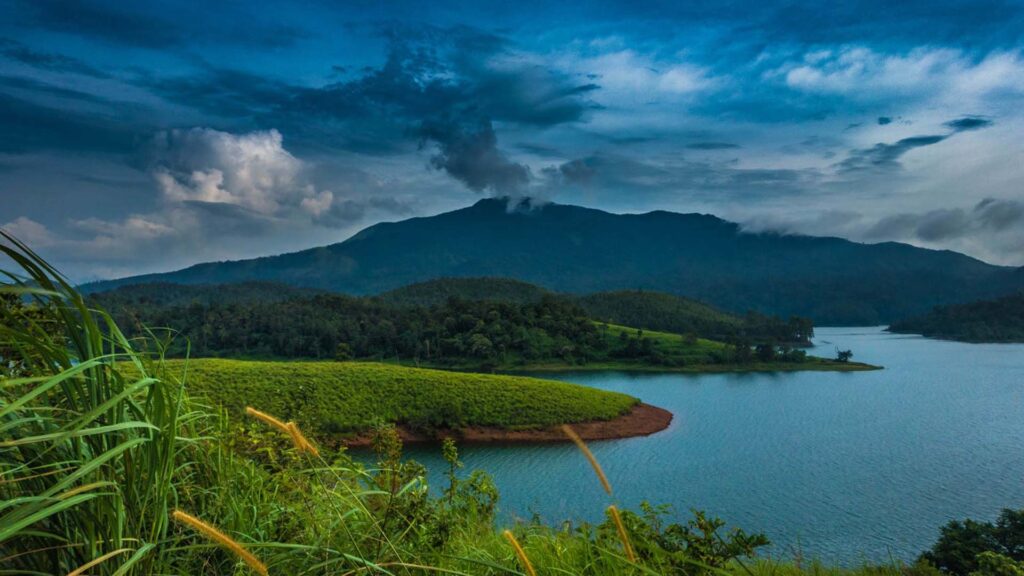
Wayanad, nestled in the serene Western Ghats of Kerala, is a picturesque hill district known for its lush green landscapes, mist-clad mountains, and rich biodiversity. Famous for its spice plantations, waterfalls, and wildlife sanctuaries, Wayanad offers a perfect blend of nature and culture. Popular attractions include Edakkal Caves with their prehistoric carvings, the scenic Banasura Sagar Dam, Soochipara Falls, and the sprawling Wayanad Wildlife Sanctuary.
Adventure seekers can enjoy trekking to Chembra Peak, which rewards them with breathtaking panoramic views, or exploring the hidden trails leading to waterfalls and caves. The region is also rich in tribal heritage, offering visitors a glimpse into Kerala’s unique traditions and lifestyles. Tea and coffee estates spread across the hills add to the scenic charm, making every journey here a visual treat.
Wayanad’s pleasant climate, coupled with its unspoiled natural beauty, makes it a year-round destination. It is also known for its Ayurvedic wellness retreats, which provide rejuvenating therapies amidst a tranquil setting. Whether you’re seeking relaxation, adventure, or cultural exploration, Wayanad offers it all in abundance.
Best time to visit: October to May
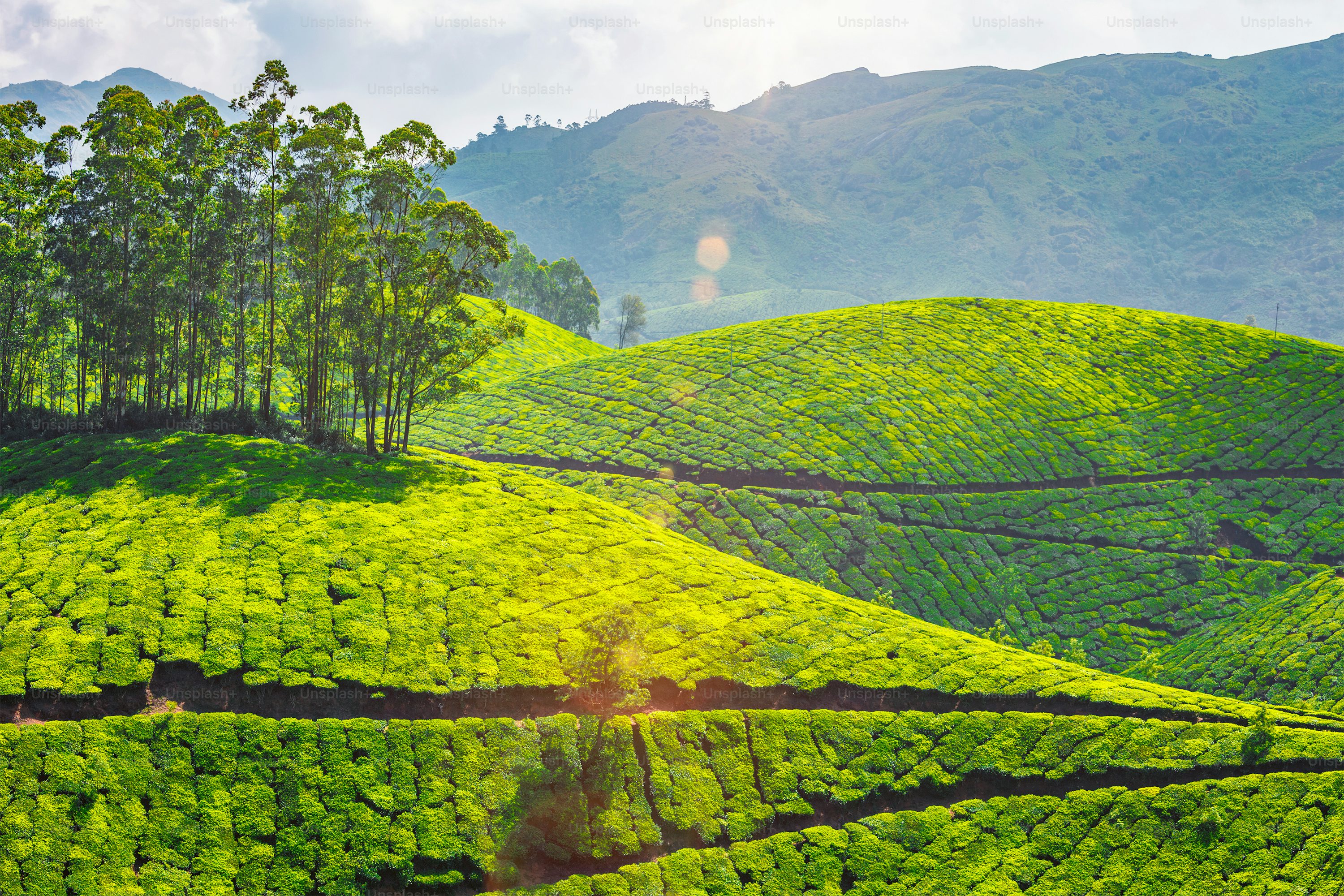
Munnar, located in the Idukki district of Kerala, is one of India’s most famous hill stations, celebrated for its endless tea plantations, rolling hills, and misty landscapes. Perched at around 1,600 meters above sea level, it offers a refreshing escape from the heat and bustle of the plains. The region is dotted with attractions like the Eravikulam National Park, home to the endangered Nilgiri Tahr, Mattupetty Dam, Echo Point, and the sprawling tea estates that paint the hills in vibrant green.
Adventure lovers can indulge in activities such as trekking to Anamudi Peak, the highest point in South India, or exploring scenic trails through cardamom and spice plantations. The tea museums and factories provide an insight into Munnar’s rich tea-making heritage, while viewpoints like Top Station offer breathtaking panoramic vistas of the Western Ghats.
Munnar’s charm lies not just in its landscapes but also in its serene pace of life. The cool breeze, aroma of tea leaves, and occasional drizzle create an atmosphere of pure tranquility. It is also a hotspot for honeymooners, nature photographers, and anyone seeking peace in the lap of nature.
Munnar also offers unique experiences like staying in charming treehouses or heritage plantation bungalows, allowing visitors to wake up to panoramic views of mist-covered valleys. The vibrant local markets brim with aromatic spices, handmade chocolates, and fresh tea leaves, making for delightful souvenirs. For wildlife enthusiasts, birdwatching is a treat here, with numerous endemic species fluttering across the hills and forests.
Best time to visit: September to May
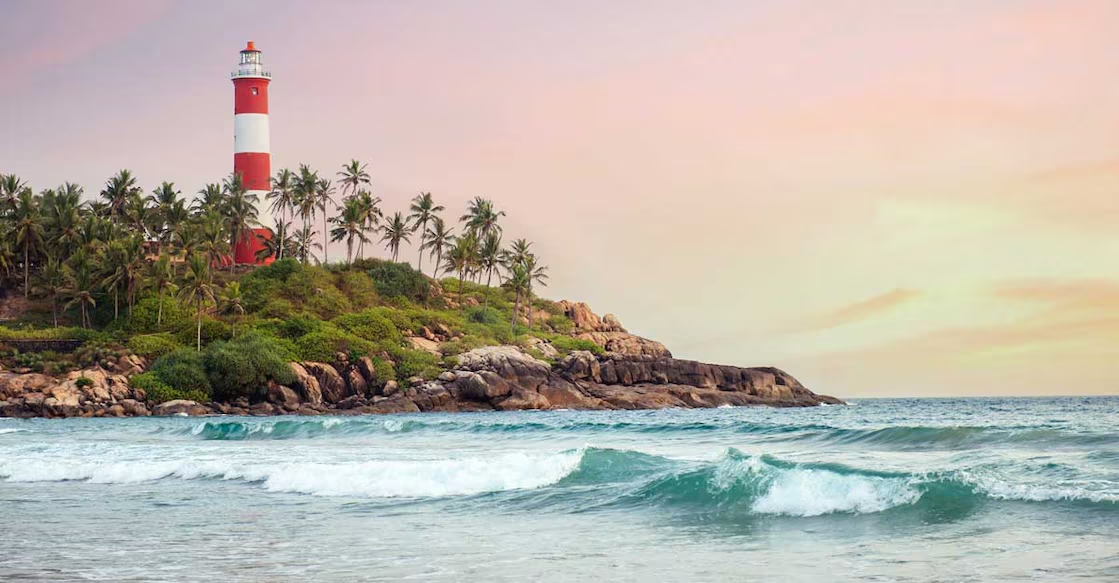
Kovalam, located along the Arabian Sea coast in Kerala, is a world-famous beach destination known for its crescent-shaped shoreline, golden sands, and swaying coconut palms. The town boasts three main beaches—Lighthouse Beach, Hawah Beach, and Samudra Beach—each offering a unique charm, from bustling tourist hubs to peaceful, secluded stretches. Kovalam is also popular for water sports like surfing, parasailing, and catamaran rides, making it a paradise for adventure lovers.
Beyond the beaches, visitors can explore Ayurvedic wellness centers offering rejuvenating massages and therapies, which have made Kovalam a hub for health tourism. The stunning sunset views from the Lighthouse Beach are especially memorable, painting the sky in shades of orange and pink. You can also take short trips to nearby attractions like Vizhinjam Marine Aquarium or the fishing harbor to experience the region’s coastal culture.
Kovalam’s laid-back atmosphere, warm hospitality, and delicious seafood make it a perfect spot for both leisure and cultural exploration. The town comes alive during local festivals, where traditional music, dance, and boat races give travelers a taste of Kerala’s heritage.
Best time to visit: September to March
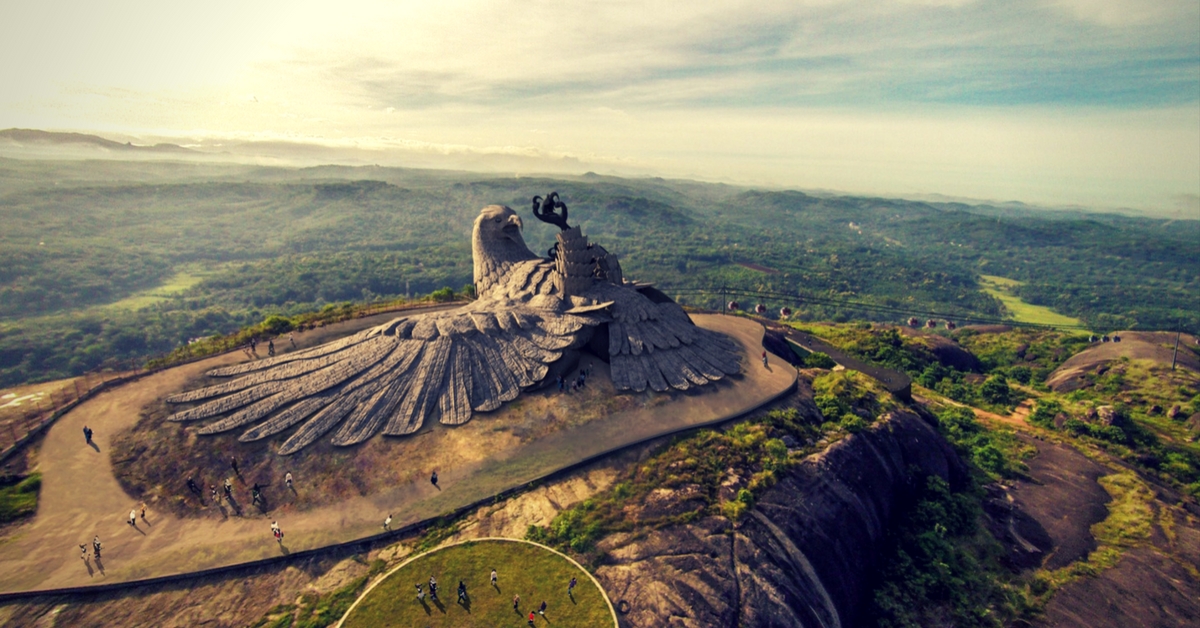
Jatayu Earth’s Center, near Kollam in Kerala, is a unique blend of mythology, art, and adventure. It features the world’s largest bird sculpture, a colossal creation measuring 200 feet long, 150 feet wide, and 70 feet high, depicting the legendary eagle Jatayu from the Ramayana. According to the epic, this is the spot where Jatayu fell after bravely trying to rescue Sita from Ravana. The center also houses an impressive audio-visual museum and a 6D theatre that narrates the heroic tale in an immersive way.
Visitors can reach the hilltop either by a scenic cable car ride or by climbing 826 stone steps that wind through the lush surroundings. Once at the top, there are adventure activities like rock climbing, zip-lining, and paintball, as well as a viewpoint offering breathtaking panoramas of the landscape. Built with eco-friendly principles, the site uses rainwater harvesting, solar energy, and sustainable landscaping to protect the natural terrain.
Apart from its historical and adventurous appeal, Jatayu Earth’s Center also serves as a symbol of women’s safety and honor, resonating with the sacrifice of Jatayu in the Ramayana. The serene natural surroundings, combined with the powerful legend, create an atmosphere that is both inspiring and reflective. Visitors often find the experience not just entertaining, but also emotionally moving, making it a memorable stop in Kerala’s cultural landscape.
Best time to visit: September and January
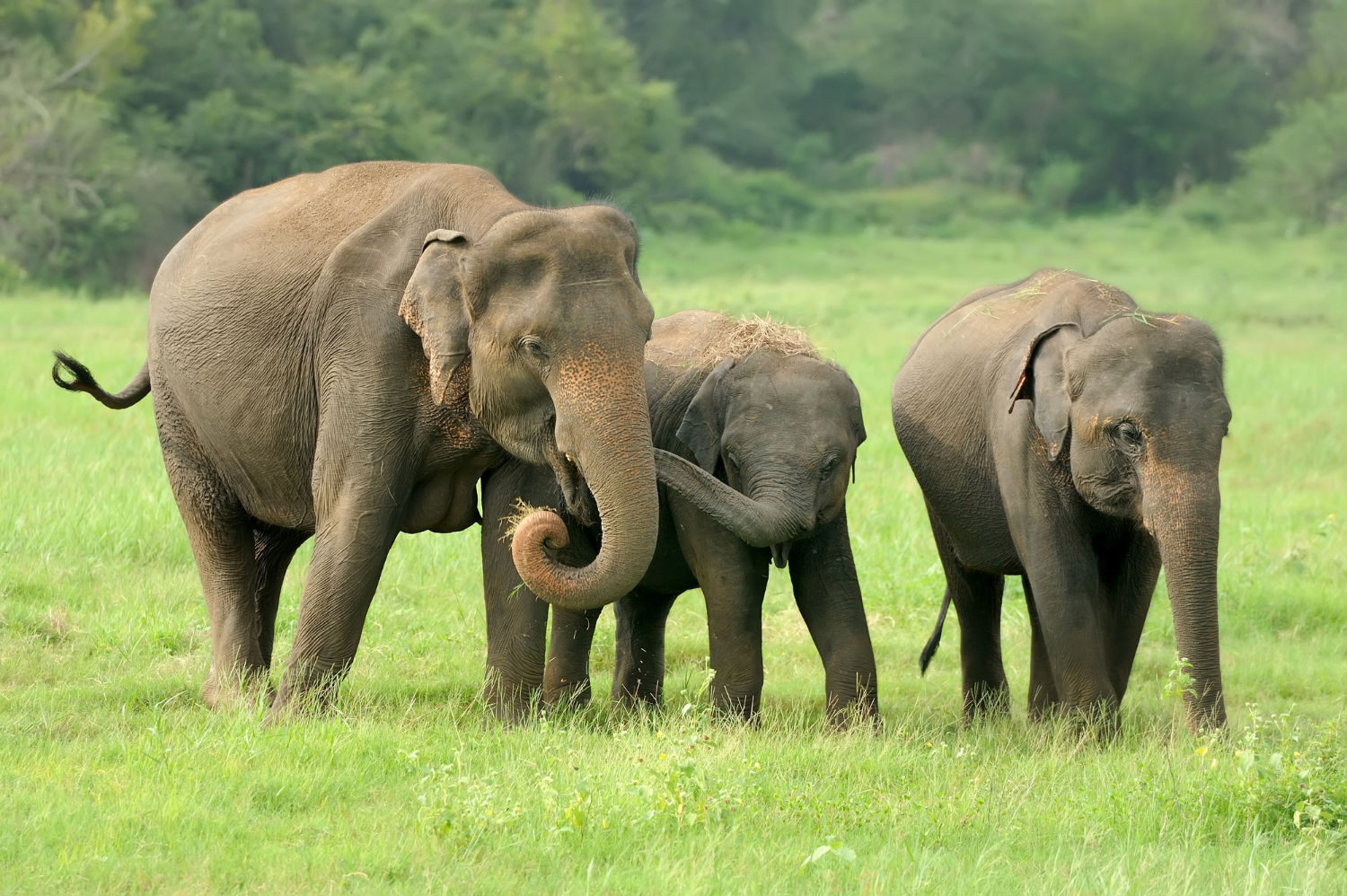
Thekkady, located in the Idukki district of Kerala, is a paradise for nature lovers and wildlife enthusiasts. It is best known for the Periyar Wildlife Sanctuary, where visitors can enjoy boat cruises on the serene Periyar Lake while spotting elephants, deer, bison, and a variety of bird species. The lush green forests, rolling hills, and spice plantations add to its charm, offering a perfect escape from city life.
Beyond wildlife, Thekkady is also famous for its spice gardens, where you can take guided tours to learn about cardamom, pepper, and other aromatic crops. Adventure seekers can enjoy trekking, bamboo rafting, and border hiking, making the destination equally appealing to thrill-seekers. The blend of nature, culture, and adventure ensures a wholesome travel experience.
The vibrant local culture, traditional Kathakali performances, and martial art shows of Kalaripayattu add a cultural flavor to the visit. Shopping for authentic Kerala spices and handicrafts is another delightful experience here. The calm, unspoiled environment makes it a great place for rejuvenation and relaxation.
Thekkady also offers a peaceful retreat for those seeking wellness and rejuvenation, with several Ayurvedic centers providing traditional therapies and massages amidst tranquil surroundings. The misty mornings, fresh mountain air, and aromatic spice-scented breeze make every moment here memorable, ensuring visitors leave with both cherished memories and a refreshed mind.
Best time to visit: September to March

Idukki, nestled in the Western Ghats of Kerala, is a picturesque district known for its lush green hills, dense forests, and serene backwaters. Famous for the Idukki Arch Dam — one of the tallest in Asia — the region is a paradise for nature lovers and adventure seekers alike. The area is dotted with spice plantations, tea gardens, and wildlife sanctuaries, making it a perfect escape from the chaos of city life. Its unspoiled beauty offers a peaceful retreat for those looking to connect with nature.
Beyond its scenic charm, Idukki is home to a variety of wildlife, including elephants, tigers, and exotic bird species, found in the Idukki Wildlife Sanctuary and Eravikulam National Park. The rolling hills and mist-covered valleys provide countless trekking and hiking opportunities, attracting both amateur and seasoned adventurers. The panoramic viewpoints such as Calvary Mount and Ramakkalmedu offer breathtaking views of the surrounding landscapes, especially during sunrise and sunset.
Idukki is also rich in cultural heritage, with local festivals and traditional art forms adding vibrancy to the region. The spice-scented breeze from cardamom and pepper plantations fills the air, creating a sensory delight for visitors. The gentle pace of life here, combined with warm hospitality, allows travelers to fully immerse themselves in the region’s charm. Whether it’s boating in calm reservoirs or exploring remote tribal villages, Idukki offers a diverse travel experience.
Best time to visit: October to February

Kuttanad, often called the “Rice Bowl of Kerala”, is a unique region in the Alappuzha district, known for its vast paddy fields that lie below sea level. This scenic land is crisscrossed by a network of rivers, canals, and backwaters, creating a mesmerizing landscape perfect for photography and relaxation. It’s also one of the few places in the world where farming is carried out below sea level, making it a rare agricultural marvel
A boat cruise through the tranquil waters of Kuttanad offers glimpses of traditional Kerala village life, lush green fields, and coconut groves swaying in the breeze. The region’s serene environment and natural charm make it a peaceful escape from the bustle of city life.
Kuttanad is also a paradise for food lovers, offering delicious local cuisine like karimeen pollichathu and kappa with fish curry, often prepared with freshly caught fish from the backwaters. The slow-paced life, friendly locals, and rich cultural traditions make every visit memorable.
Kuttanad is also famous for its vibrant festivals and traditional snake boat races held during Onam, where long, beautifully decorated boats race through the backwaters to the rhythm of energetic boat songs. These events not only showcase the region’s cultural heritage but also create an electrifying atmosphere that draws visitors from all over the world.
Best time to visit: October to March

Chinnar Wildlife Sanctuary, located in the Idukki district of Kerala, is a protected area rich in biodiversity and unique landscapes. Known for its dry thorn forests, rolling hills, and river valleys, the sanctuary is home to rare species like the endangered grizzled giant squirrel, Indian star tortoise, and numerous medicinal plants. Traversed by the Chinnar and Pambar rivers, the sanctuary also features cascading waterfalls and serene trekking trails, making it a paradise for nature enthusiasts and wildlife photographers.
The sanctuary offers exciting activities such as guided wildlife safaris, birdwatching, and trekking to scenic viewpoints like Thoovanam Waterfalls. Visitors can also explore tribal villages within the sanctuary to learn about the traditional lifestyles of the local communities. The combination of nature, adventure, and culture creates a memorable experience for all kinds of travelers.
With over 200 species of birds and 225 recorded species of fauna, Chinnar Wildlife Sanctuary is a hotspot for eco-tourism. Its unique dry climate, unlike the rest of Kerala’s lush greenery, offers a different kind of beauty, particularly during the post-monsoon months.
Best time to visit: December to April
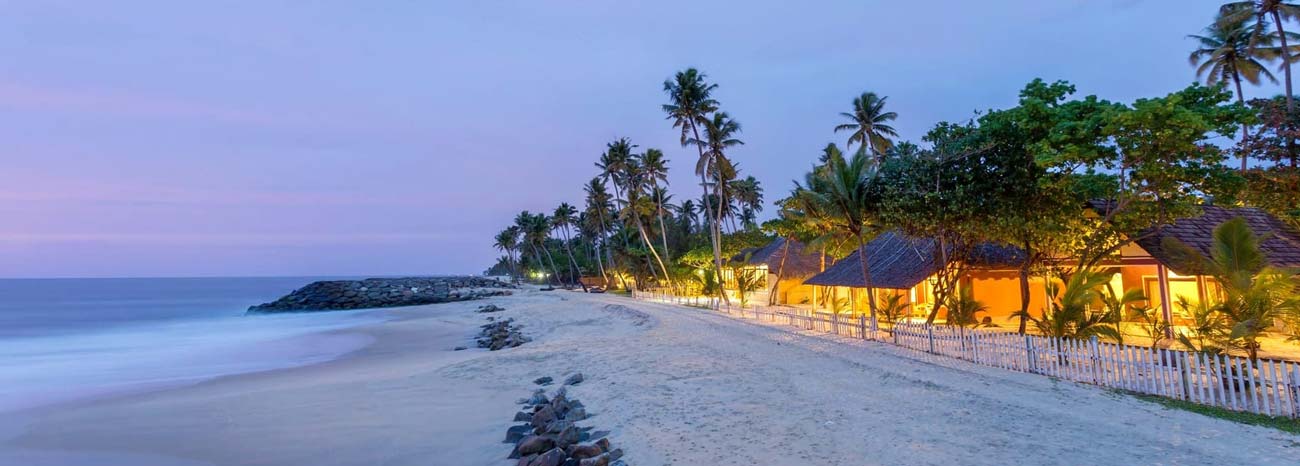
Marari Beach, located in the Alappuzha district of Kerala, is a serene and less-crowded coastal destination perfect for relaxation. Known for its golden sands, swaying coconut palms, and calm Arabian Sea waves, it offers a peaceful escape from busy tourist spots. The beach is ideal for sunbathing, swimming, and enjoying mesmerizing sunsets that paint the sky with vibrant colors.
Visitors can indulge in activities like beach volleyball, cycling through nearby fishing villages, or trying fresh seafood prepared in traditional Kerala style. Ayurvedic spas and yoga retreats near the beach add to its charm, making it a rejuvenating getaway.
Marari also offers opportunities to experience local culture, with fishermen heading out in traditional boats and markets showcasing handicrafts and coir products. Its unspoiled beauty makes it a favorite among travelers seeking a slow, laid-back holiday.
Best time to visit: November to March
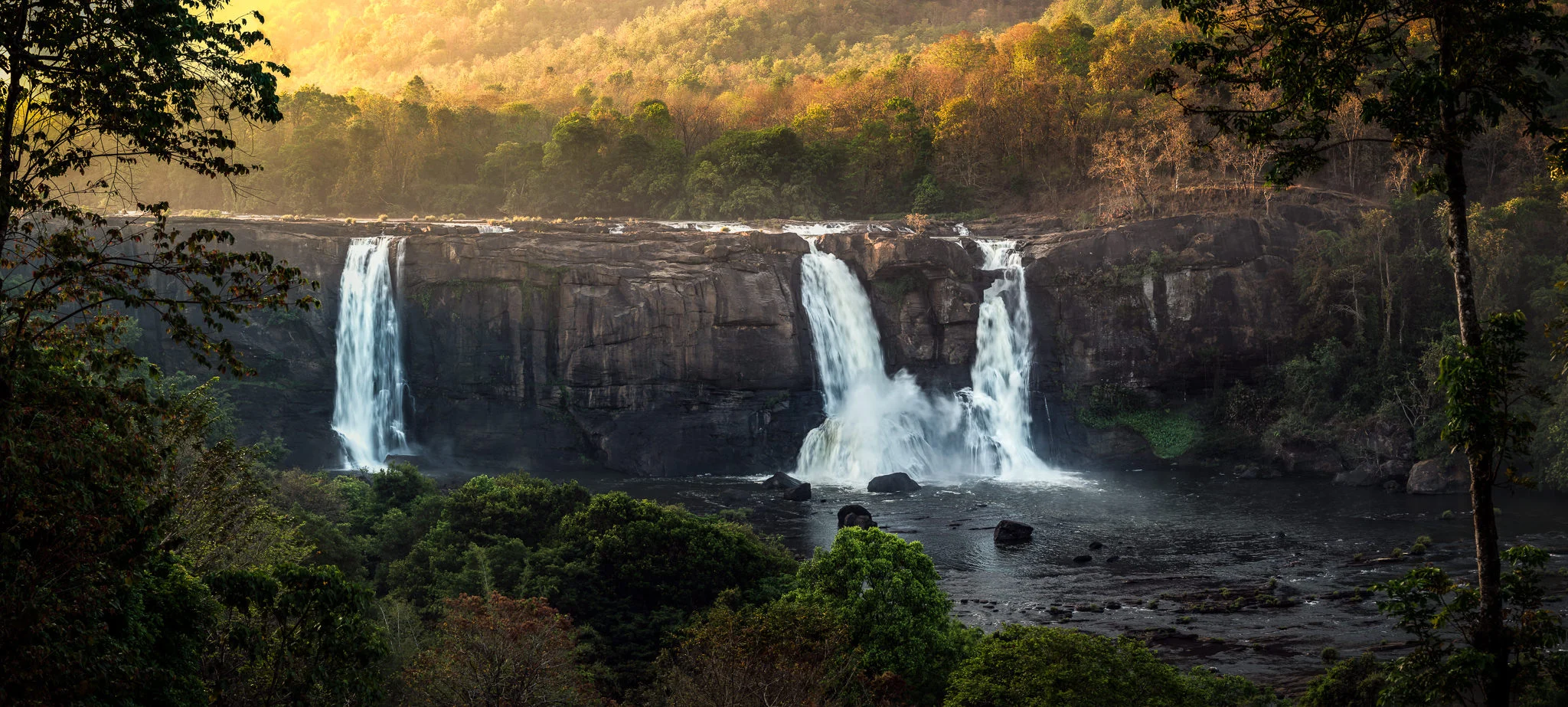
Athirappilly Waterfalls, often called the “Niagara of India,” is the largest waterfall in Kerala, located in the Thrissur district. Cascading from a height of about 80 feet, it creates a breathtaking sight as the Chalakudy River gushes down amidst lush green forests. The roaring sound of the falls, combined with the mist in the air, offers a mesmerizing experience for nature lovers.
Surrounded by the Western Ghats, Athirappilly is also a haven for wildlife enthusiasts, as the area is home to species like the Malabar hornbill, lion-tailed macaque, and Indian elephant. The scenic trails around the falls provide perfect spots for photography and peaceful walks.
Visitors can also explore nearby attractions such as Vazhachal Waterfalls and Charpa Falls, which are just a short drive away. The monsoon season enhances the waterfall’s grandeur, though the post-monsoon months are ideal for safe and comfortable visits.
Best time to visit: September to January
